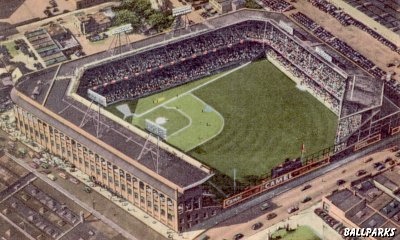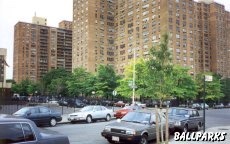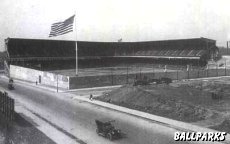Ebbets Field
Brooklyn, New York
Tenant: Brooklyn Dodgers (NL)
Opened: April 9, 1913
First night game: June 15, 1938
Last game: September 24, 1957
Demolished: February 23, 1960
Surface: Grass
Capacity: 25,000 (1913); 32,000 (1932)
Architect: Clarence Randall Van Buskirk
Construction: Castle Brothers, Inc.
Owner: Brooklyn Dodgers
Cost: $750,000
Los Angeles Dodgers tickets:
Location: 55 Sullivan Place, in the Flatbush section of Brooklyn (about three miles south by southeast down Flatbush Avenue from the Manhattan Bridge). Left field (N), Montgomery Street; third base (W), Franklin Avenue, later Cedar Place, later McKeever Place; first base (S), Sullivan Place; right field (E), Bedford Avenue.
Dimensions: Left field: 419 (1913), 410 (1914), 418.75 (1921), 383.67 (1926), 382.83 (1930), 384 (1931), 353 (1932), 356.33 (1934), 365 (1938), 357 (1939), 365 (1940), 356 (1942), 357 (1947), 343 (1948), 348 (1953), 343 (1955), 348 (1957). (There is some confusion about distances because the left-field foul line and grandstand wall were the same near the corner between the 343 and 357 markers.) Left-center: 365 (1932), 351 (1948); deep left-center at bend in wall: 407 (1932), 393 (1948), 395 (1954); center field: 450 (1914), 466 (1930), 460.79 (early 1931), 447 (late 1931), 399.42 (1932), 399 (1936), 402 (1938), 400 (1939), 399 (1947), 384 (1948), 393 (1955); right side of center-field grandstand: 390 (1932), 376 (1948); right-centerís deepest corner: 500 (1913), 476.75 (1926), 415 (1932), 403 (1948), 405 (1950), 403 (1955); right side of rightĖcenter field exit gate: 399 (1932); right-center: 352; scoreboard: left side 344, right side 318; right field: 301 (1913), 300 (1914), 296.17 (1921), 292 (1922), 301 (1926), 296.08 (1930), 295.92 (1931), 296.5 (1934), 297 (1938); backstop: 64 (1942), 70.5 (1954), 72 (1957).
Fences: Left field to left-center: 20 (1913), 3 (wood, 1920), 9.87 (concrete, 1931); center field: 20 (1913), 393 marker: 9.87 (concrete, 1931) sloping upward; 376 marker: 15 (concrete, 1931); right-center: 9 (concrete, 1913), from 376 point to screen: 15 sloping upward to 19, then down to 13; right-center to right field 38 (top 19 screen, bottom 19 concave concrete wall, bent at 9.5 midpoint, vertical top half, concave angled bottom half); screen in center field: 20 (screen above sloping concrete, 1920s); right field before the screen: 9 (concrete, 1913).
Trivia:
- Named after Dodgers owner Charles Ebbets.
- Rotunda was an 80-foot circle enclosed in Italian marble, with a floor tiled with a representation of the stitches of a baseball and a chandelier with 12 baseball-bat arms holding 12 globes shaped like baseballs.
- There were 12 turnstiles and 12 gilded ticket windows. The domed ceiling was 27 feet high at its center.
- Kids could watch games through a gap under the metal gate in right-center.
- Cobblestoned Bedford Avenue was a hill, climbing from a low point in right field to higher ground in center field.
- Right-field wall and scoreboard (built after 1930) had approximately 289 different angles; the scoreboard jutted out 5 feet from the wall at a 45-degree angle. Overhang of the second deck hung out over center field.
- Abe Stark sign offered a free suit at 1514 Pitkin Avenue to any batter hitting the 3-by-30-foot sign.
- Baseball's first televised baseball game was played here by the Dodgers on August 26, 1939 against the Reds.
- Jackie Robinson became the first black man in the 20th century to play in Major League Baseball here on April 15, 1947.
- In the late forties, Gladys Gooding played songs like "To each his own" on an organ situated in an overhang in the girders beneath the upper deck behind first base at Ebbets Field while the players were warming up and during the 7th inning stretch.
- Hosted the 1949 All-Star game.
- The only year in which the Dodgers won the World Series while tennants of Ebbets Field was 1955.
- Built on the site of the Pigtown garbage dump at a cost of $750,000.
- No press box until 1929.
- In the winter of 1931-32, the double deck was extended from third base to the left field corner and across to center field.
- In the winter of 1937-38, box seats were added in center field.
- In the winter of 1947-48, more seats were added to left and center.
- Schaefer Beer sign (added after WWII) on top of the right-center scoreboard notified fans of official scorerís decision - the 'H' in Schaefer lit up for a hit, an 'E' for an error.
- Demolition began on February 23, 1960. The same wrecking ball was used four years later to demolish the Polo Grounds.
- For a period of time, the scoreboard clock sat on top of the right-field scoreboard at McCormick Field in Asheville, North Carolina.
- Eight light towers were moved to Downing Stadium on Randallís Island.
- Ebbets Field Apartments now occupies the site.
- Jackie Robinson School, previously known as Crown Heights, houses the Brooklyn Dodgers Hall of Fame.
Recommended Reading (bibliography):
- The Greatest Ballpark Ever: Ebbets Field and the Story of the Brooklyn Dodgers by Bob McGee.
- Ebbets Field: Brooklyn's Baseball Shrine by Joseph McCauley.
- Ebbets: The History and Genealogy of a New York Family by Edward E. Steele.
- The Dodgers Move West by Neil J. Sullivan.
- Babe Ruth Slept Here: The Baseball Landmarks of New York City by Jim Reisler.
- Take Me Out to the Ballpark: An Illustrated Tour of Baseball Parks Past and Present by Josh Leventhal and Jessica Macmurray.
- The Ballpark Book: A Journey Through the Fields of Baseball Magic (Revised Edition) by Ron Smith and Kevin Belford.
- City Baseball Magic: Plain Talk and Uncommon Sense about Cities and Baseball Parks by Philip Bess.
- Diamonds: The Evolution of the Ballpark by Michael Gershman.
- Green Cathedrals: The Ultimate Celebration of All 273 Major League and Negro League Ballparks by Philip J. Lowry.
- Lost Ballparks: A Celebration of Baseball's Legendary Fields by Lawrence S. Ritter.
- Roadside Baseball: A Guide to Baseball Shrines Across America by Chris Epting.
- The Story of America's Classic Ballparks (VHS).
Help us provide a better web site by completing our feedback form
PHOTOGRAPHS:
Aerial view of Ebbets Field courtesy of Elias Dudash.
View of McKeever and Sullivan back then courtesy of Elias Dudash.
View of McKeever and Sullivan now © 1999 by Paul Munsey.
Upper deck view of Ebbets Field by Munsey & Suppes.
View of Ebbets Field from the 1st base side by Munsey & Suppes.
View of Ebbets Field from the 3rd base side by Munsey & Suppes.
Ebbets Field in 1913 courtesy of the Brown Brothers.
Updated September 2005
Tickets to Los Angeles Dodgers, NCAA Basketball Tournament, College Football Bowl, NCAA Football, New York Mets, New York Yankees, Paul McCartney and Wicked New York provided by Ticket Triangle.
BALLPARKS © 1996-2014 by Munsey & Suppes.
|










